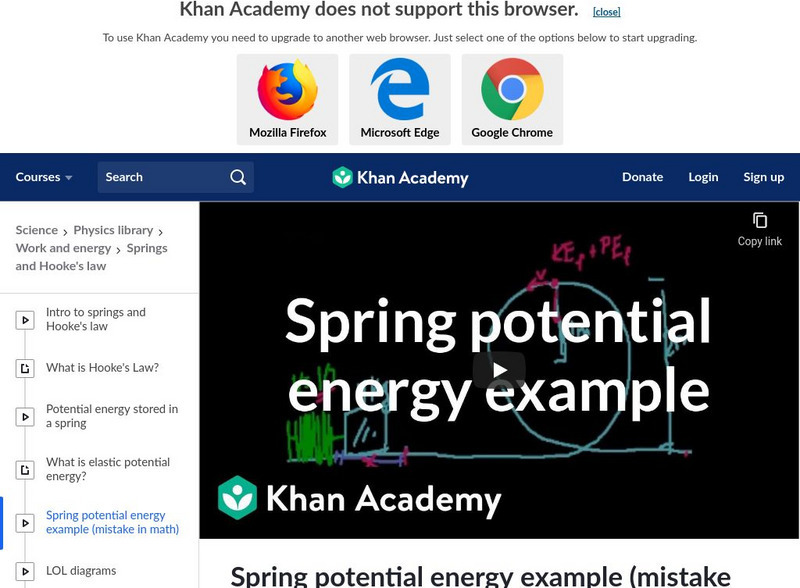Hi, what do you want to do?
Khan Academy
Khan Academy: Social Perception the Halo Effect
This video describes the different ways in which our perception of an individual can be affected by our overall impression or our particular impression about a single attribute. [5:14]
Khan Academy
Khan Academy: Social Perception Primacy Recency
This video explains the difference between the primacy theory and recency theory regarding social perception. Which is stronger? Why do first impressions count so much? [4:51]
Khan Academy
Khan Academy: Social Movements
This video discusses the different types of social movements and why and how they form. [7:34]
Khan Academy
Khan Academy: Social Influences
This video looks at how imitation, roles, reference groups, and culture are all parts of social influence. [11:27]
Khan Academy
Khan Academy: Social Facilitation and Social Loafing
Does the presence of others help or hinder performance? It depends. Watch this Khan Academy video for an explanation. [4:37]
Khan Academy
Khan Academy: Social Theories Overview (Part 2)
This is part 2 of Social Theories Overview. This video explains Feminist Theory and Rational Exchange Theories. [4:08]
Khan Academy
Khan Academy: Social Theories Overview (Part 1)
An overview of functionalism, conflict theory, social constructionism, and symbolic interactionism to help you keep them all straight. By Sydney Brown. [4:10]
Khan Academy
Khan Academy: Social Support
In times of need, your social network can provide social support in a multitude of ways. This video explains four main types of social support that we can provide for each other. [3:36]
Khan Academy
Khan Academy: Sp3 Hybridization
Understand sp3 hybrid orbitals and properties of sigma bonds. [10:43]
Khan Academy
Khan Academy: Sp2 Hybridization
Understand sp2 hybrid orbitals and properties of pi bonds. [12:41]
Khan Academy
Khan Academy: Specific Heat and Latent Heat of Fusion and Vaporization
Defining specific heat, heat of fusion, and heat of vaporization. How to calculate the amount of heat to change the temperature of water and the energy required to change for a phase change. [14:57]
Khan Academy
Khan Academy: Special Cases: Histidine, Proline, Glycine, Cysteine
Certain amino acids stand out for their unique properties. In this video, you'll learn more about what makes histidine, proline, glycine, and cysteine unique. [8:18]
Khan Academy
Khan Academy: Spin Spin Splitting (Coupling)
How peaks in a proton NMR can get split into multiplets due to coupling with neighboring protons. [12:22]
Khan Academy
Khan Academy: Sp Hybridization
In sp hybridization, the 2s orbital and a 2p orbital hybridize to form two sp orbitals, each consisting of 50% s character and 50% p character. The front lobes point away from each other (creating a 180 degree angle between the two...
Khan Academy
Khan Academy: Specular and Diffuse Reflection 2
Learn about specular and diffuse reflection 2. [7:41]
Khan Academy
Khan Academy: Sound Properties: Amplitude, Period, Frequency, Wavelength
How to find the amplitude, period, frequency, and wavelength for a sound wave. [5:16]
Khan Academy
Khan Academy: Somatosensory Homunculus
Review of the somatosensory homunculus, which is basically a topological representation of the body in the brain.
Khan Academy
Khan Academy: Standard Reduction Potentials
How to use a table of standard reduction potentials to calculate standard cell potential. Identifying trends in oxidizing and reducing agent strength. [9:09]
Khan Academy
Khan Academy: Standard Change in Free Energy and the Equilibrium Constant
The relationship between standard Gibbs free energy change and the equilibrium constant K. Calculating K when you know the standard free energy of reaction. [10:45]
Khan Academy
Khan Academy: Standard Cell Potential and the Equilibrium Constant
Understand standard cell potential and the equilibrium constant. [4:37]
Khan Academy
Khan Academy: Spring Potential Energy Example (Mistake in Math)
A spring, a frozen loop-d-loop and more! [9:39]
Khan Academy
Khan Academy: Spontaneity and Redox Reactions
Using standard cell potential to predict whether a redox reaction will be spontaneous under standard conditions. [12:21]




























